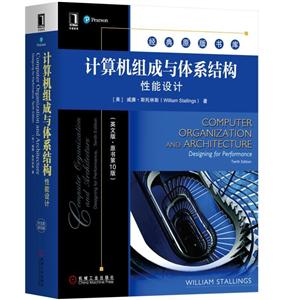经典原版书库计算机组成与体系结构:性能设计(英文版 原书第10版)/(美)威廉.斯托林斯
本书特色
[
本书以Intel x86体系结构和ARM两个处理器系列为例,将当代计算机系统性能设计问题与计算机组成的基本概念和原理紧密联系起来,介绍了当代计算机体系结构的主流技术和*新技术。
]
内容简介
[
本书以Intel x86体系结构和ARM两个处理器系列为例,将当代计算机系统性能设计问题与计算机组成的基本概念和原理紧密联系起来,介绍了当代计算机体系结构的主流技术和*新技术。
]
作者简介
[
威廉·斯托林斯(William Stallings) 知名计算机图书作者,曾13次获得美国教材和学术专著作者协会颁发的年度*佳计算机科学教材奖。目前,他是一名独立顾问,为众多计算机和网络制造商、软件开发公司以及政府前沿研究机构提供服务。
]
目录
**部分 引言第1章 基本概念和计算机演化11.1 组成与体系结构21.2 结构与功能31.3 计算机简史111.4 Intel x86体系结构的演化271.5 嵌入式系统291.6 ARM体系结构331.7 云计算391.8 关键词、复习题和练习题42第2章 性能问题452.1 优化性能设计462.2 多核、MIC和GPGPU522.3 深刻理解性能的两个定律:Ahmdahl定律和Little定律532.4 计算机性能的基本度量562.5 计算均值592.6 基准测试和SPEC672.7 关键词、复习题和练习题74第二部分 计算机系统第3章 计算机功能与互连的顶层视图803.1 计算机组件813.2 计算机功能833.3 互连结构993.4 总线互连1003.5 点对点互连1023.6 PCI Express1073.7 关键词、复习题和练习题116第4章 高速缓存1204.1 计算机存储系统概述1214.2 高速缓存存储器原理1284.3 高速缓存设计要素1314.4 Pentium 4 高速缓存结构1494.5 关键词、复习题和练习题152附录4A 两级存储的性能特征157第5章 内部存储器1655.1 半导体主存1665.2 纠错1745.3 DDR DRAM1805.4 闪存1855.5 新的非易失性固态存储器技术1875.6 关键词、复习题和练习题190第6章 外部存储器1946.1 磁盘1956.2 RAID2046.3 固态硬盘2126.4 光学存储器2176.5 磁带2226.6 关键词、复习题和练习题224第7章 输入/输出2287.1 外部设备2307.2 I/O模块2327.3 可编程I/O2357.4 中断驱动的I/O2397.5 直接存储器访问2487.6 直接高速缓存访问2547.7 I/O通道和处理器2617.8 外部互连标准2637.9 IBM zEnterprise EC12 I/O系统2667.10 关键词、复习题和练习题270第8章 操作系统支持2758.1 操作系统概述2768.2 调度2878.3 存储管理2938.4 Intel x86存储管理3048.5 ARM存储管理3098.6 关键词、复习题和练习题314第三部分 算术与逻辑第9章 数字系统3189.1 十进制系统3199.2 按位记数系统3209.3 二进制系统3219.4 二进制与十进制的转换3219.5 十六进制表示3249.6 关键词和练习题326第10章 计算机算术运算32810.1 算术与逻辑单元32910.2 整数表示33010.3 整数算术运算33510.4 浮点表示35010.5 浮点算术运算35810.6 关键词、复习题和练习题367第11章 数字逻辑37211.1 布尔代数37311.2 门37611.3 组合电路37811.4 时序电路39611.5 可编程逻辑设备40511.6 关键词和练习题409第四部分 中央处理单元第12章 指令集:特点与功能41212.1 机器指令特点41312.2 操作数类型42012.3 Intel x86和ARM的数据类型42212.4 操作类型42512.5 Intel x86和ARM的操作类型43812.6 关键词、复习题和练习题446附录12A 小端序、大端序和双端序452第13章 指令集:寻址模式与格式45613.1 寻址模式45713.2 x86和ARM的寻址模式46313.3 指令格式46913.4 x86和ARM指令格式47713.5 汇编语言48213.6 关键词、复习题和练习题484第14章 处理器结构与功能48814.1 处理器组成48914.2 寄存器组成49114.3 指令周期49614.4 指令流水线50014.5 x86处理器系列51714.6 ARM处理器52414.7 关键词、复习题和练习题530第15章 精简指令集计算机53515.1 指令执行特性53715.2 大寄存器文件的使用54215.3 基于编译器的寄存器优化54715.4 精简指令集架构54915.5 RISC流水线55515.6 MIPS R400055915.7 SPARC56515.8 RISC与CISC之争57015.9 关键词、复习题和练习题571第16章 指令级并行与超标量处理器57516.1 概述57616.2 设计问题58116.3 Intel Core微架构59116.4 ARM Cortex-A859616.5 ARM Cortex-M360416.6 关键词、复习题和练习题608第五部分 并行结构第17章 并行处理61317.1 多处理器结构61517.2 对称多处理器61717.3 高速缓存一致性和MESI协议62117.4 多线程和片上多处理器62817.5 集群63317.6 非均匀内存访问64017.7 云计算64317.8 关键词、复习题和练习题650第18章 多核计算机65618.1 硬件性能问题65718.2 软件性能问题66018.3 多核结构66518.4 异构多核结构66718.5 Intel Core i7-990X67618.6 ARM Cortex-A15 MPCore67718.7 IBM zEnterprise EC12大型机68218.8 关键词、复习题和练习题685第19章 通用图形处理单元68819.1 CUDA基础68919.2 GPU与CPU69119.3 GPU架构概述69219.4 Intel的Gen8 GPU70119.5 何时把GPU当作协处理器使用70419.6 关键词和复习题706第六部分 控制单元第20章 控制单元操作70720.1 微操作70820.2 处理器的控制71420.3 硬布线实现72420.4 关键词、复习题和练习题727第21章 微程序控制72921.1 基本概念73021.2 微指令序列73921.3 微指令执行74521.4 TI 880075521.5 关键词、复习题和练习题766附录A 计算机组成与体系结构教学项目768附录B 汇编语言与相关主题774参考文献800Contents Foreword xiii Preface xv About the Author xxiii PART ONE INTRODUCTION 1 Chapter.1 Basic Concepts and Computer Evolution 1 1.1 Organization and Architecture 2 1.2 Structure and Function 3 1.3 A Brief History of Computers 11 1.4 The Evolution of the Intel x86 Architecture 27 1.5 Embedded Systems 29 1.6 Arm Architecture 33 1.7 Cloud Computing 39 1.8 Key Terms, Review Questions, and Problems 42 Chapter.2 Performance Issues 45 2.1 Designing for Performance 46 2.2 Multicore, Mics, and GPGPUs 52 2.3 Two Laws that Provide Insight:Ahmdahl’s Law and Little’s Law 53 2.4 Basic Measures of Computer Performance 56 2.5 Calculating the Mean 59 2.6 Benchmarks and Spec 67 2.7 Key Terms, Review Questions, and Problems 74 PART TWO THE COMPUTER SYSTEM 80 Chapter.3 A Top-Level View of Computer Function and Interconnection 80 3.1 Computer Components 81 3.2 Computer Function 83 3.3 Interconnection Structures 99 3.4 Bus Interconnection 100 3.5 Point-to-Point Interconnect 102 3.6 PCI Express 107 3.7 Key Terms, Review Questions, and Problems 116 Chapter.4 Cache Memory 120 4.1 Computer Memory System Overview 121 4.2 Cache Memory Principles 128 4.3 Elements of Cache Design 131 4.4 Pentium 4 Cache Organization 149 4.5 Key Terms, Review Questions, and Problems 152 Appendix 4A Performance Characteristics of Two-Level Memories 157 Chapter.5 Internal Memory 165 5.1 Semiconductor Main Memory 166 5.2 Error Correction 174 5.3 DDR DRAM 180 5.4 Flash Memory 185 5.5 Newer Nonvolatile Solid-State Memory Technologies 187 5.6 Key Terms, Review Questions, and Problems 190 Chapter.6 External Memory 194 6.1 Magnetic Disk 195 6.2 RAID 204 6.3 Solid State Drives 212 6.4 Optical Memory 217 6.5 Magnetic Tape 222 6.6 Key Terms, Review Questions, and Problems 224 Chapter.7 Input/Output 228 7.1 External Devices 230 7.2 I/O Modules 232 7.3 Programmed I/O 235 7.4 Interrupt-Driven I/O 239 7.5 Direct Memory Access 248 7.6 Direct Cache Access 254 7.7 I/O Channels and Processors 261 7.8 External Interconnection Standards 263 7.9 IBM zEnterprise EC12 I/O Structure 266 7.10 Key Terms, Review Questions, and Problems 270 Chapter.8 Operating System Support 275 8.1 Operating System Overview 276 8.2 Scheduling 287 8.3 Memory Management 293 8.4 Intel x86 Memory Management 304 8.5 Arm Memory Management 309 8.6 Key Terms, Review Questions, and Problems 314 PART THREE ARITHMETIC AND LOGIC 318 Chapter.9 Number Systems 318 9.1 The Decimal System 319 9.2 Positional Number Systems 320 9.3 The Binary System 321 9.4 Converting Between Binary and Decimal 321 9.5 Hexadecimal Notation 324 9.6 Key Terms and Problems 326 Chapter.10 Computer Arithmetic 328 10.1 The Arithmetic and Logic Unit.329 10.2 Integer Representation 330 10.3 Integer Arithmetic 335 10.4 Floating-Point Representation 350 10.5 Floating-Point Arithmetic 358 10.6 Key Terms, Review Questions, and Problems 367 Chapter.11 Digital Logic 372 11.1 Boolean Algebra 373 11.2 Gates 376 11.3 Combinational Circuits 378 11.4 Sequential Circuits 396 11.5 Programmable Logic Devices 405 11.6 Key Terms and Problems 409 PART FOUR THE CENTRAL PROCESSING UNIT.412 Chapter.12 Instruction Sets: Characteristics and Functions 412 12.1 Machine Instruction Characteristics 413 12.2 Types of Operands 420 12.3 Intel x86 and ARM Data Types 422 12.4 Types of Operations 425 12.5 Intel x86 and ARM Operation Types 438 12.6 Key Terms, Review Questions, and Problems 446 Appendix 12A Little-, Big-, and Bi-Endian 452 Chapter.13 Instruction Sets:Addressing Modes and Formats 456 13.1 Addressing Modes 457 13.2 x86 and ARM Addressing Modes 463 13.3 Instruction Formats 469 13.4 x86 and ARM Instruction Formats 477 13.5 Assembly Language 482 13.6 Key Terms, Review Questions, and Problems 484 Chapter.14 Processor Structure and Function 488 14.1 Processor Organization 489 14.2 Register Organization 491 14.3 Instru
封面

书名:经典原版书库计算机组成与体系结构:性能设计(英文版 原书第10版)/(美)威廉.斯托林斯
作者:[美]威廉·斯托林斯WilliamSta
页数:808
定价:¥229.0
出版社:机械工业出版社
出版日期:2018-05-01
ISBN:9787111631460
PDF电子书大小:159MB 高清扫描完整版
